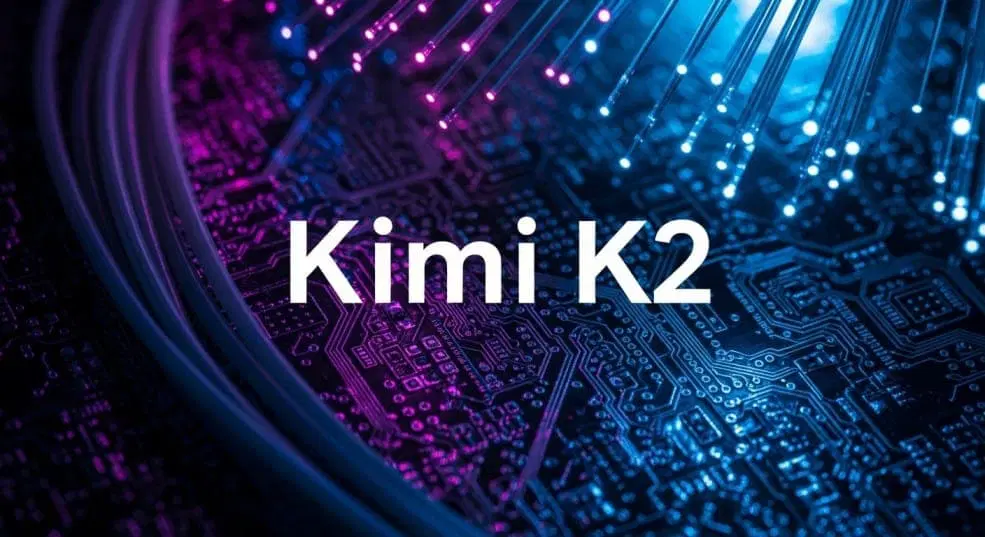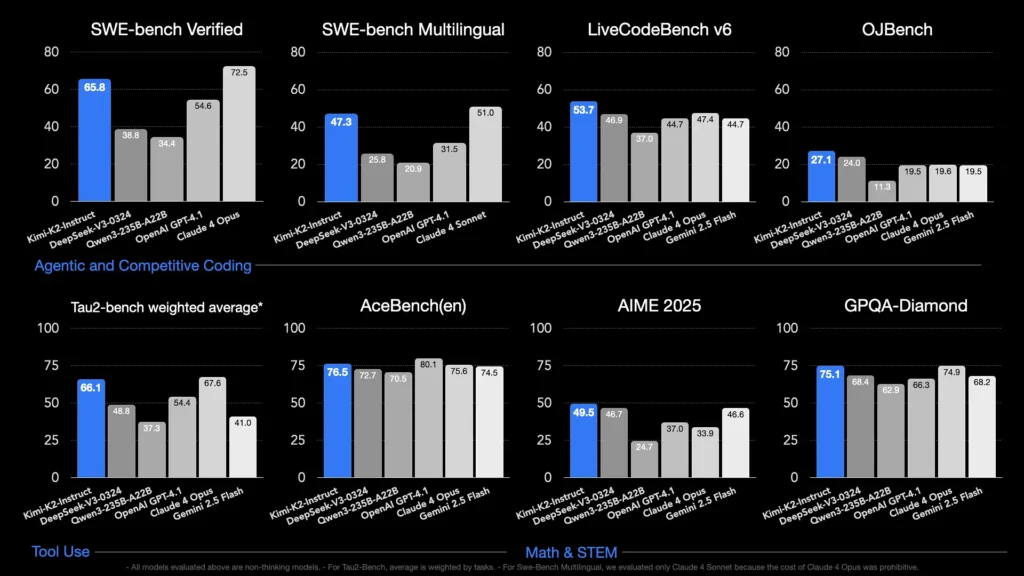Moonshot ‘s Kimi K2: A Overview of Next‑Generation Mixture‑of‑Experts Model

Moonshot AI, a rising star in China’s AI landscape, has officially launched Kimi K2, its next-generation large language model based on a cutting-edge Mixture-of-Experts (MoE) architecture. The announcement marks a significant leap forward in performance, scalability, and efficiency, positioning Moonshot AI at the forefront of global AI innovation.
What is Kimi K2?
Kimi K2, announced by Moonshot AI (Beijing) on July 11, 2025, is the company’s latest and largest open source AI model, a gigantic model with 1 trillion parameters and 32B activation parameters using the Mixture-of-Experts (MoE) architecture . The company positions this as a model that emphasizes “agentic intelligence” and has designed it specifically for tool utilization, code generation, and autonomous task execution .It excels on code generation, mathematical reasoning, and knowledge‑based QA, and—crucially—has been specifically optimized for “agentic” tasks, meaning it doesn’t just answer questions but can autonomously complete multi‑step workflows.
Moonshot has simultaneously open-sourced two types of software: “Kimi-K2-Base” (for researchers and developers) and “Kimi-K2-Instruct” (for chat and agent applications). APIs are also now available, emphasizing the versatility that can compete with traditional proprietary models .
- Kimi‑K2‑Base: the foundational model, intended for research and custom fine‑tuning.
- Kimi‑K2‑Instruct: an instruction‑tuned version, optimized for general chat and lightweight agent applications.
Key Capabilities
- Multi‑step Task Execution
- Code Generation & Debugging
- Data Analysis & Visualization
- Automatic Tool Invocation
- Strong On‑Premise/Local Deployment Support
Moonshot’s goal is to deliver a fully “open‑agent” AI platform that lets developers and researchers build systems capable of invoking external tools and proactively carrying out complex tasks.
Why did Moonshot AI launch Kimi K2?
Market environment and competitive structure
In China, as DeepSeek, Baidu, Alibaba, Tencent and others intensified competition, Moonshot temporarily had a presence in the fields of medium- and long-text analysis and search in 2024. However, due to the spread of DeepSeek, which had a low-cost model first, the ranking of the Kimi app’s monthly active users dropped from the top three to seventh in early 2025 .
For this reason, in order to attract attention again, Moonshot has decided to adopt a strategy of open sourcing a model that can be used in the global market. The company aims to achieve both “performance and accessibility” while referring to the strategies adopted by Meta (LLaMA, etc.).
Why open source?
Major US AI companies (OpenAI, Google, etc.) tend to operate their latest models in a closed manner. Meanwhile, major Chinese players have adopted the open source route, and Moonshot will continue that trend. Open source has the advantages of increased reliability, expanding the developer ecosystem, and strengthening international brand power.
How is Kimi K2 designed?
MoE architecture
“Kimi K2” is a MoE structure with 1 trillion total parameters. For each input, a 32B subset is activated, and 8 experts are selected from 384 experts. This enables extremely efficient calculations compared to the number of parameters .
MuonClip optimizer
Moonshot’s proprietary technology “MuonClip” is a new optimization method to eliminate instability that is a problem in training models on a trillion-scale. This avoids the need for retraining worth millions of dollars, and achieves both training stability and cost efficiency at the same time .
Task‑Driven Self‑Supervision
- Kimi‑K2 isn’t just trained on static text: it practices on simulated tasks (report writing, code fixing, chart generation, webpage creation).
- It generates its own training samples and uses a secondary evaluator model to score its outputs, iteratively refining its abilities.
Autonomous Planning & Tool Use
- Plans multi‑step procedures (e.g., “analyze salaries by location → plot results → write commentary”) and decides which tool or API to call at each step, acting like a compact intelligent agent.
Developer‑Friendly Agent Deployment
- Works out‑of‑the‑box with simple API calls or local inference—no complex middleware or orchestration pipelines required.
Comprehensive Skill Set
- Code: read/write/debug, cross‑file refactors, automated testing
- Math: algebra, geometry, probability, statistics at near–GPT‑4 level
- Data Analysis: tabular reasoning, charting, interactive reports
- Web Generation: direct data‑to‑HTML/JS/page outputs
- CLI Automation: full terminal command support with retry logic
What is the performance of Kimi K2?
Benchmark Performance
- Surpasses GPT‑4.1 and Claude Sonnet in multiple code benchmarks.
- Reads, modifies, and debugs multi‑file codebases; can automatically port projects (e.g., Flask → Rust) or generate full web apps.
Furthermore, it achieved a very high score of 97.4% in the MATH-500 (mathematics benchmark), and also demonstrated its strengths in the “agent-based” tool utilization benchmark .

Balance between performance and price
Moonshot has introduced pricing that takes OpenAI and Anthropic into consideration, with API usage fees of $0.15 per 1M input tokens and $2.50 per output token. It appeals to corporate customers with a tactic of low cost and high performance.
How can Kimi K2 be used?
Usage
- Host open source model (Base/Instruct) in your own environment. * Call from an app using API using OpenAI/Anthropic compatible protocol.
Model checkpoints are published on Hugging Face and other sites. vLLM, SGLang, KTransformers, and TensorRT-LLM are recommended as inference engines .
Simple usage example
Chat completion (Instruct model example):
client.chat.completions.create(
model="kimi-k2-instruct",
messages=[{"role":"system","content":"You are Kimi..."},
{"role":"user","content":"Introduce yourself"}],
temperature=0.6,
max_tokens=256
)Tool calling is also possible:
tools=[{ ... weather tool schema ... }]
client.chat.completions.create(..., tools=tools, tool_choice="auto")The above configuration allows autonomous tool use during conversation.
Where can I get Kimi K2?
- The model and code are available from the GitHub repository.
- Can also be used on the Moonshot platform via API.
- Wrapping for external infrastructure such as Hugging Face is also available, making it easy to build an advanced development environment.
How much does Kimi K2 cost?
API price:
- \$0.15 per 1 M input tokens (cache hit)
- \$0.60 per 1 M input tokens (cache miss)
- \$2.50 per 1 M output tokens
Free for self-hosting, but server and GPU costs are required. Cost optimization is possible by selecting an inference engine.
Competitive environment: Compared to OpenAI and Anthropic, it is set with an emphasis on superiority in terms of performance vs. price.
What will change with the introduction of Kimi K2?
1. Spread of cost-efficient large-scale AI
The effect of MuonClip, which suppresses the occurrence of huge training costs, may make it possible for general users and small and medium-sized enterprises to handle MoE large-scale models.
2. Improving quality through the expansion of the ecosystem
Open sourcing allows researchers and developers from all over the world to participate and advance applications and improvements. The goal is to achieve cumulative quality improvements through shared datasets, forks, and communities.
3. Expanding applications to social implementation
Kimi K2-Instruct’s “agent” function paves the way for highly practical AI tools that can be used not only for chat and search, but also for automation, report generation, software development assistance, etc.
Getting Started
CometAPI is a unified API platform that aggregates over 500 AI models from leading providers—such as OpenAI’s GPT series, Google’s Gemini, Anthropic’s Claude, Midjourney, Suno, and more—into a single, developer-friendly interface. By offering consistent authentication, request formatting, and response handling, CometAPI dramatically simplifies the integration of AI capabilities into your applications. Whether you’re building chatbots, image generators, music composers, or data‐driven analytics pipelines, CometAPI lets you iterate faster, control costs, and remain vendor-agnostic—all while tapping into the latest breakthroughs across the AI ecosystem.
The latest integration Gemini 2.5 Flash‑LiteI will soon appear on CometAPI, so stay tuned!While we finalize Gemini 2.5 Flash‑Lite Model upload, explore our other models on the Models page or try them in the AI Playground.
Developers can access latest Claude 4 API(Deadline for article publication): Claude Opus 4 , Gemini 2.5 Pro Preview and Grok 4 through CometAPI. To begin, explore the model’s capabilities in the Playground and consult the API guide for detailed instructions. Before accessing, please make sure you have logged in to CometAPI and obtained the API key. CometAPI offer a price far lower than the official price to help you integrate.
Summary: Is Kimi K2 a symbol of a new era of AI?
Moonshot AI’s “Kimi K2” is a model that combines the elements of next-generation AI – open source, large-scale MoE, cost-effective training, and agentization – into one. In particular, it is noteworthy that it can be widely distributed at a low price while showing excellent performance in code generation, mathematics, and tool integration tasks.
This strategy goes beyond simply disclosing technology, and has the potential to promote dialogue and collaboration between researchers, developers, and companies, and become the standard for open source AI. It may also be an opportunity for Moonshot AI itself and Chinese companies as a whole to regain an advantage in international competition.
